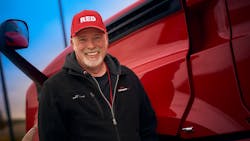Reaching peak fuel efficiency: How to achieve 10 MPGs
LOUISVILLE, Kentucky—With diesel prices still averaging over $4, fleets and owner-operators alike are always looking for ways to cut fuel costs. Three drivers who, during NACFE’s first Run on Less event, achieved more than 10 miles per gallon on their trucks, advised an audience of drivers and trucking stakeholders on how to get the most from every drop of fuel at the Mid-America Trucking Show.
Aerodynamic investments can save up to 15% in fuel
Henry Albert, an owner-operator who runs Albert Transport, said by optimizing aerodynamics, he sees fuel savings of up to 15%. During a MATS panel, he asked the audience a simple question.
“With all the battles we have to fight in this industry,” Albert asked, “why pick a fight with the air?”
See also: How to improve engine efficiency and service life
Albert recommends fleets and drivers look at their trucks for dirty spots. Those dirty spots—"anything that kills bugs,” he said, indicate where there is a high vacuum.
Albert optimizes his trailer gap, keeping about 18 inches from the end of the cab extender to the trailer. He installed a nose cone on the trailer, which he did not expect would have a great effect, but the back of his cab no longer gets dirty, meaning a vacuum was sealed.
Trailer skirts are equipment Albert considers a “no-brainer” for fuel efficiency, and he recommended straight skirts because they are the most aerodynamic, noting that Walmart and Schneider uses straight skirts in their fleets.
There is also another, less obvious trailer technology that offered night-and-day efficiency gains for Albert.
“The one that probably surprised me the most—and that I wanted the least—was a trailer tail,” he said.
He installed a trailer tail from a provider that advertised 5% to 7% efficiency gains—a claim that Albert was dubious of, especially considering he had already improved his fuel efficiency by 9.5%. To his surprise, the trailer tail further improved his fuel savings by 6.8%.
“How you close the air is just as important as how you open it up at the front.”
Even something as innocuous as where a trailer license plate is installed can tip the needle for fuel savings by hundreds of dollars. It costs from $400 to $700 per year to have a license plate mounted below the taillights (assuming fuel is $3). Most manufacturers now have the option to mount the license plate on the rear buckplate, Albert said.
Make a move on engine idling
Clark Reed, a driver with Nussbaum Transportation said idling is the biggest waste of fuel and expressed frustration over when he sees drivers needlessly idling at truck stops for merely, say, running in for a sandwich.
Reed said he spends three to four weeks on the road at a time living out of his truck, and his idle time is less than 1%. He attributes this to using auxiliary power units (APUs)—both diesel-powered or electric—and Freighliner’s ParkSmart HVAC system over the years. Now, Reed’s truck has solar panels that charge the APU and truck batteries and extend overall battery life.
If drivers don’t have an APU, Reed recommended electric mattress heaters and fans to plug into power outlets to stay comfortable at night.
Nussbaum used to incentivize MPG only, according to Reed, but now incentivizes habits instead.
“The problem with that is, if you have a couple bad days because the wind is fighting you, because you’ve got heavy loads, all the driver sees is that MPG number and feels they are losing money.”
By monitoring habits such as following distance and truck speed, Nussbaum can maintain their fuel savings without having to account for variables such as wind speed and terrain—with the added bonus of increased safety, Reed said.
Downspeeding drives down diesel (and maintenance) costs
Joel Morrow, CEO of Alpha Drivers Testing & Consulting, a consulting firm for optimizing drivetrains for owner-operators and fleets, extolled the virtues of downsped powertrains.
“Just like we have exponential increases in fuel usage when we don’t have aerodynamics, the same thing happens with mechanical drag in the engine. We refer to this as piston speed; we want to slow the piston speed down.”
Lower piston speed also helps to hold heat in the combustion process, easing strain on the emissions system. Downsped trucks have fewer emissions systems problems, Morrow said.
“It’s almost outweighed the actual fuel efficiency benefit of it. Fuel efficiency’s pretty stellar, but the reduction in maintenance costs to go along with it really makes the new downsped powertrains kind of a no-brainer.”
About the Author
Scott Keith
Scott Keith is an associate editor at FleetOwner.

